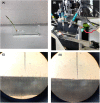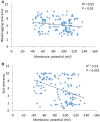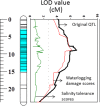Cell-Based Phenotyping Reveals QTL for Membrane Potential Maintenance Associated with Hypoxia and Salinity Stress Tolerance in Barley
- PMID: 29201033
- PMCID: PMC5696338
- DOI: 10.3389/fpls.2017.01941
Cell-Based Phenotyping Reveals QTL for Membrane Potential Maintenance Associated with Hypoxia and Salinity Stress Tolerance in Barley
Abstract
Waterlogging and salinity are two major abiotic stresses that hamper crop production world-wide resulting in multibillion losses. Plant abiotic stress tolerance is conferred by many interrelated mechanisms. Amongst these, the cell's ability to maintain membrane potential (MP) is considered to be amongst the most crucial traits, a positive relationship between the ability of plants to maintain highly negative MP and its tolerance to both salinity and waterlogging stress. However, no attempts have been made to identify quantitative trait loci (QTL) conferring this trait. In this study, the microelectrode MIFE technique was used to measure the plasma membrane potential of epidermal root cells of 150 double haploid (DH) lines of barley (Hordeum vulgare L.) from a cross between a Chinese landrace TX9425 and Japanese malting cultivar Naso Nijo under hypoxic conditions. A major QTL for the MP in the epidermal root cells in hypoxia-exposed plants was identified. This QTL was located on 2H, at a similar position to the QTL for waterlogging and salinity tolerance reported in previous studies. Further analysis confirmed that MP showed a significant contribution to both waterlogging and salinity tolerance. The fact that the QTL for MP was controlled by a single major QTL illustrates the power of the single-cell phenotyping approach and opens prospects for fine mapping this QTL and thus being more effective in marker assisted selection.
Keywords: H+-ATPase; Hordeum vulgare; hypoxia; membrane potential; salinity tolerance; waterlogging tolerance.
Figures






Similar articles
-
A single locus is responsible for salinity tolerance in a Chinese landrace barley (Hordeum vulgare L.).PLoS One. 2012;7(8):e43079. doi: 10.1371/journal.pone.0043079. Epub 2012 Aug 20. PLoS One. 2012. PMID: 22916210 Free PMC article.
-
Identification of QTL Related to ROS Formation under Hypoxia and Their Association with Waterlogging and Salt Tolerance in Barley.Int J Mol Sci. 2019 Feb 6;20(3):699. doi: 10.3390/ijms20030699. Int J Mol Sci. 2019. PMID: 30736310 Free PMC article.
-
Quantitative Trait Loci for Salinity Tolerance Identified under Drained and Waterlogged Conditions and Their Association with Flowering Time in Barley (Hordeum vulgare. L).PLoS One. 2015 Aug 6;10(8):e0134822. doi: 10.1371/journal.pone.0134822. eCollection 2015. PLoS One. 2015. PMID: 26247774 Free PMC article.
-
Opportunities for Improving Waterlogging Tolerance in Cereal Crops-Physiological Traits and Genetic Mechanisms.Plants (Basel). 2021 Jul 29;10(8):1560. doi: 10.3390/plants10081560. Plants (Basel). 2021. PMID: 34451605 Free PMC article. Review.
-
Phenotyping for waterlogging tolerance in crops: current trends and future prospects.J Exp Bot. 2022 Sep 3;73(15):5149-5169. doi: 10.1093/jxb/erac243. J Exp Bot. 2022. PMID: 35642593 Free PMC article. Review.
Cited by
-
High-throughput root phenotyping of crop cultivars tolerant to low N in waterlogged soils.Front Plant Sci. 2023 Sep 13;14:1271539. doi: 10.3389/fpls.2023.1271539. eCollection 2023. Front Plant Sci. 2023. PMID: 37780519 Free PMC article. No abstract available.
-
Transmembrane potential, an indicator in situ reporting cellular senescence and stress response in plant tissues.Plant Methods. 2023 Mar 21;19(1):27. doi: 10.1186/s13007-023-01006-0. Plant Methods. 2023. PMID: 36945027 Free PMC article.
-
Genome-wide association scan and transcriptome analysis reveal candidate genes for waterlogging tolerance in cultivated barley.Front Plant Sci. 2022 Dec 15;13:1048939. doi: 10.3389/fpls.2022.1048939. eCollection 2022. Front Plant Sci. 2022. PMID: 36589094 Free PMC article.
-
Genome-Wide Analysis of Gene Expression Provides New Insights into Waterlogging Responses in Barley (Hordeum vulgare L.).Plants (Basel). 2020 Feb 13;9(2):240. doi: 10.3390/plants9020240. Plants (Basel). 2020. PMID: 32069892 Free PMC article.
-
Identification of QTL for Stem Traits in Wheat (Triticum aestivum L.).Front Plant Sci. 2022 Jul 14;13:962253. doi: 10.3389/fpls.2022.962253. eCollection 2022. Front Plant Sci. 2022. PMID: 35909739 Free PMC article.
References
-
- Armstrong W., Drew M. (2002). “Root growth and metabolism under oxygen deficiency,” in Plant Roots: The Hidden Half, eds Wasel Y., eshel A., kafkafi U. (New York, NY: Marcel Dekker, Inc.), 729–761.
-
- Arzani A., Ashraf M. (2016). Smart engineering of genetic resources for enhanced salinity tolerance in crop plants. Crit. Rev. Plant Sci. 35 146–189. 10.1080/07352689.2016.1245056 - DOI
-
- Aslam M., Qureshi R., Ahmed N. (1993). A rapid screening technique for salt tolerance in rice (Oryza sativa L.). Plant Soil 150 99–107. 10.1007/BF00779180 - DOI
LinkOut - more resources
Full Text Sources
Other Literature Sources

